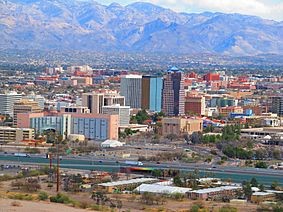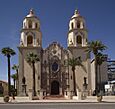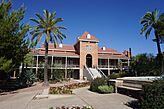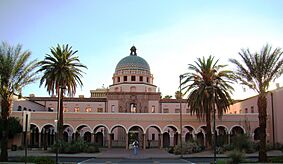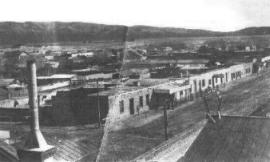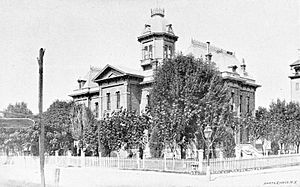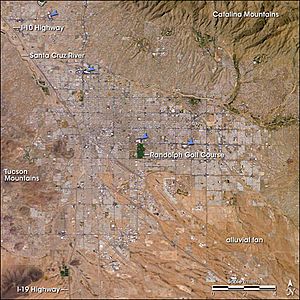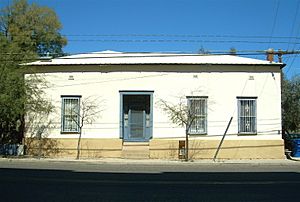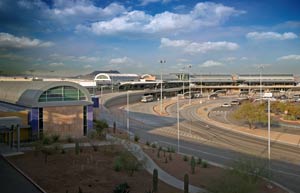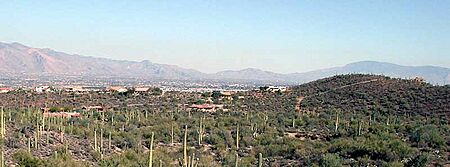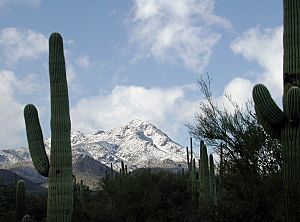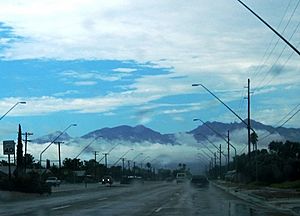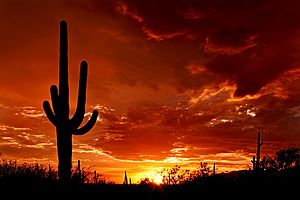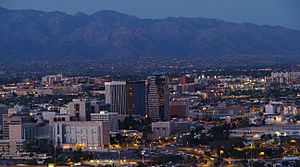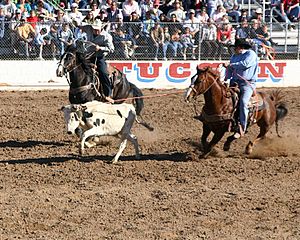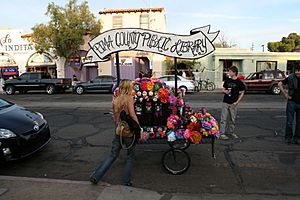Tucson, Arizona facts for kids
Quick facts for kids
Tucson
|
||
|---|---|---|
|
Downtown Tucson skyline
Old Main, University of Arizona
Pima County Courthouse
|
||
|
||
| Etymology: from Cuk Ṣon, meaning 'the base (of the hill) is black' | ||
| Nicknames:
"The Old Pueblo", "Optics Valley", "America's biggest small town"
|
||
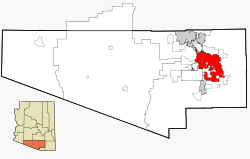
Location within Pima County
|
||
| Country | United States | |
| State | Arizona | |
| County | Pima | |
| Settled | c. 1300 A.D | |
| Founded | August 20, 1775 | |
| Incorporated | February 7, 1877 | |
| Founded by | Hugo O'Conor | |
| Ward |
6 Wards
Ward 1
Ward 2 Ward 3 Ward 4 Ward 5 Ward 6 |
|
| Government | ||
| • Type | Council–manager | |
| • Body | Tucson City Council | |
| Area | ||
| • City | 241.33 sq mi (625.04 km2) | |
| • Land | 241.01 sq mi (624.22 km2) | |
| • Water | 0.32 sq mi (0.82 km2) | |
| Elevation | 2,389 ft (728 m) | |
| Population
(2020)
|
||
| • City | 542,629 | |
| • Rank | 88th in North America 33rd in the United States 2nd in Arizona |
|
| • Density | 2,251.44/sq mi (869.29/km2) | |
| • Urban | 875,441 (US: 52nd) | |
| • Urban density | 2,449.8/sq mi (945.9/km2) | |
| • Metro | 1,043,433 (US: 53rd) | |
| Demonym(s) | Tucsonian; Tucsonan | |
| Time zone | UTC-07:00 (MST (no DST)) | |
| ZIP Codes |
85701-85719, 85721, 85723-85726, 85728, 85730-85752, 85754-85757, 85775
|
|
| Area code | 520 | |
| FIPS code | 04-77000 | |
| GNIS feature ID | 43534 | |
| 1 Urban = 2010 Census | ||
Tucson (pronounced TOO-sawn) is a big city in Arizona, United States. It's the main city of Pima County. Tucson is also home to the famous University of Arizona. It's the second-largest city in Arizona, right after Phoenix. In 2020, about 542,629 people lived here. If you count the whole area around Tucson, the population is over 1 million!
Tucson is about 108 miles southeast of Phoenix. It's also only 60 miles north of the border with Mexico. Many smaller towns and communities are near Tucson. These include Oro Valley, Marana, Sahuarita, and South Tucson.
Spanish explorers founded Tucson as a military fort in 1775. This happened when Hugo Oconór ordered the building of the Presidio San Agustín del Tucsón. Mexico took control in 1821 after gaining independence from Spain. The U.S. bought this area in 1853 as part of the Gadsden Purchase. Tucson was the capital of the Arizona Territory from 1867 to 1877. It was Arizona's biggest city for a long time until Phoenix grew larger by 1920.
The name "Tucson" comes from the O'odham language. The word Cuk Ṣon means "the base of the hill is black." This refers to Sentinel Peak, a basalt-covered hill nearby. Tucson is often called "The Old Pueblo." It's also known as "Optics Valley" because of its important work in optical science and telescopes. In 2015, UNESCO named Tucson the first "City of Gastronomy" in the U.S. This means it's famous for its food!
Contents
- Tucson's Past: A Look Back
- Tucson's Location and Landscape
- Tucson's Weather and Climate
- Tucson's People
- Tucson's Economy and Jobs
- Arts and Culture in Tucson
- Sports and Fun in Tucson
- Education in Tucson
- Media in Tucson
- How Tucson Works: Infrastructure
- Notable People from Tucson
- Sister Cities
- Images for kids
- See also
Tucson's Past: A Look Back
People have lived in the Tucson area for a very long time. Early people, called Paleo-Indians, were here about 12,000 years ago. Near the Santa Cruz River, archaeologists found a village from 2100 BC. These early people farmed using irrigation canals. They grew corn and beans. They also hunted and gathered wild plants.
Later, the Hohokam people lived here from AD 600 to 1450. They built large irrigation systems. They also made special red-on-brown pottery.
How Tucson Began
The first European to visit the Santa Cruz River valley was Eusebio Francisco Kino in 1692. He was a Jesuit missionary. In 1700, he started the Mission San Xavier del Bac nearby. A separate settlement was built along the Santa Cruz River. This was near the base of what is now "A" Mountain.
On August 20, 1775, Hugo Oconór ordered a military fort built there. It was called Presidio San Agustín del Tucsón. The current downtown Pima County Courthouse is near this old fort. During the Spanish time, the Apache people often attacked the fort. The town eventually became known as Tucsón. This was a Spanish version of the O'odham word.
Mexico gained independence from Spain in 1821. Tucson then became part of the state of Sonora in Mexico. During the Mexican–American War (1846–1848), U.S. forces briefly took Tucson. But it soon went back to Mexican control.
The U.S. bought southern Arizona, including Tucson, from Mexico in 1854. This was called the Gadsden Purchase. The U.S. military took control in March 1856. The town's name became "Tucson" in English.
Tucson's Growth and Changes
In 1857, Tucson became a stop for the San Antonio–San Diego Mail Line. This was a stagecoach route. In 1858, it became a main office for the Butterfield Overland Mail. This mail service stopped in 1861 because of Apache attacks.
Tucson officially became a city in 1877. This makes it the oldest city in Arizona. In 1885, the University of Arizona was founded. It was built on ranchland between Tucson and Fort Lowell.
By 1900, Tucson had 7,531 people. By 1910, the population grew to 13,913. Around this time, the U.S. Veterans Administration started building a hospital here. Tucson's clean, dry air was good for veterans with breathing problems. It was also thought to be good for treating tuberculosis.
The city kept growing. In 1912, Arizona became a state. This meant Tucson had been under five different flags: Spanish, Mexican, United States, Confederate, and the State of Arizona.
For a long time, Tucson was Arizona's biggest city. It was also a major business center. But Phoenix grew faster and became larger by 1920. Still, Tucson's population has grown a lot. Both Tucson and Phoenix have been among the fastest-growing cities in the U.S.
Tucson's Location and Landscape
Tucson covers about 226.71 square miles of land. It sits about 2,643 feet above sea level. Tucson is in the Sonoran Desert. It's surrounded by five mountain ranges. These include the Santa Catalina Mountains to the north. The Tucson Mountains are to the west.
The city is built along the Santa Cruz River. This river used to flow all year. Now, it's usually dry. But it floods during heavy seasonal rains.
I-10 runs through Tucson. It connects the city to Phoenix in the northwest. It also goes southeast towards New Mexico and Texas. I-19 goes south from Tucson to the U.S.–Mexico border. I-19 is special because it uses "kilometer posts" instead of "mileposts."
Exploring Tucson's Neighborhoods
Tucson has many unique neighborhoods. The city center is at Stone Avenue and Broadway Boulevard. This area has shifted as Tucson has grown eastward.
Downtown and Central Tucson
Downtown Tucson is the city's heart. It includes historic areas like El Presidio. This is Tucson's oldest neighborhood. Barrio Histórico and Armory Park are also nearby. Many old adobe houses can be found here.
The downtown area has been redeveloped. The Tucson Convention Center is a major part of this. Historic buildings include the Hotel Congress and the Fox Tucson Theatre. The Rialto Theatre and St. Augustine Cathedral are also important landmarks. The old Pima County Courthouse is a beautiful building. El Charro Café, Tucson's oldest restaurant, is downtown.
Central Tucson is anchored by Broadway Village shopping center. The 4th Avenue Shopping District is also popular. It has many unique stores. The University of Arizona is in midtown. It includes Arizona Stadium and McKale Center. The historic Tucson High School is also here. Reid Park, Tucson's largest park, is in midtown. It has the Reid Park Zoo. Central Tucson is known for being very bicycle-friendly.
Southern Tucson
South Tucson is a small, independent town. It's surrounded by the City of Tucson. Most of its residents are Mexican-American or Native American. It's famous for its Mexican restaurants. The south side of Tucson also has the Tucson International Airport.
Western Tucson
West Tucson has both city and suburban areas. It includes the Santa Cruz River banks. The Tucson Mountains are also here. Popular spots include the International Wildlife Museum. Saguaro National Park West is a must-see. The Old Tucson Studios is a movie set and theme park.
Sentinel Peak, west of downtown, has a giant "A" on it. This "A" honors the University of Arizona. Students used to whitewash it every year. Now, its color changes for different reasons.
Northern Tucson
North Tucson has urban neighborhoods like Amphitheater. It also has major shopping areas. Many upscale shops and restaurants are here. The Catalina Foothills community is north of the city. It has many expensive homes and resorts.
The DeGrazia Gallery of the Sun is a famous art gallery. It was built by artist Ted DeGrazia. The northwest area has rural communities and master-planned communities. Casas Adobes was Tucson's first suburb. It's home to Tohono Chul Park, a nature preserve.
Eastern Tucson
East Tucson is newer. It was built mostly from the 1950s to the 1970s. It has higher real estate values. Saguaro National Park East is in this area. "Restaurant Row" is also on the east side. The Davis-Monthan Air Force Base is in southeast Tucson. The community of Rita Ranch is home to many military families.
Tucson's Weather and Climate
Tucson has a hot desert climate. It has two main seasons: a hot summer and a mild winter. Tucson gets about 10.61 inches of rain each year. Most rain falls during winter storms and summer monsoons. Fall and spring are usually sunny and dry.
Summer Weather
Summer days are very hot, usually between 98 and 102°F. Nights are warm, between 71 and 77°F. Early summer is dry and clear. Later in summer, it gets more humid with clouds and frequent rain. The sun is very strong. People need to protect their skin. Hikers should be careful of heat stroke.
The monsoon season usually starts around July 3. During this time, humidity is much higher. Thunderstorms and heavy rain are common. This can cause flash floods. Some underpasses in Tucson have signs to warn drivers about flood levels. There's a "Stupid Motorist Law" to stop people from driving into flooded roads.
Winter Weather
Tucson winters are mild. Daytime highs are usually between 65 and 70°F. Overnight lows are between 40 and 44°F. Temperatures can drop to the 20s a few nights each winter. Snow rarely falls in the lower parts of Tucson. But it's common in the Santa Catalina Mountains.
The record high temperature was 117°F in June 1990. The record low was 6°F in January 1913. Tucson gets about 158 days a year with temperatures of 90°F or higher. It has about 12 days a year where temperatures drop to freezing or below.
Tucson's People
| Historical population | |||
|---|---|---|---|
| Census | Pop. | %± | |
| 1850 | 400 | — | |
| 1860 | 915 | 128.8% | |
| 1870 | 3,215 | 251.4% | |
| 1880 | 7,007 | 117.9% | |
| 1890 | 5,150 | −26.5% | |
| 1900 | 7,531 | 46.2% | |
| 1910 | 13,193 | 75.2% | |
| 1920 | 20,292 | 53.8% | |
| 1930 | 32,506 | 60.2% | |
| 1940 | 35,752 | 10.0% | |
| 1950 | 45,454 | 27.1% | |
| 1960 | 212,892 | 368.4% | |
| 1970 | 262,933 | 23.5% | |
| 1980 | 330,537 | 25.7% | |
| 1990 | 405,371 | 22.6% | |
| 2000 | 486,699 | 20.1% | |
| 2010 | 520,116 | 6.9% | |
| 2020 | 542,629 | 4.3% | |
| U.S. Decennial Census 2010–2020 |
|||
In 2020, Tucson had 542,629 people. About 43.6% of people were White (not Hispanic). About 42.2% were Hispanic or Latino. The largest group of people in Tucson are of Mexican heritage.
Tucson is known for having a low level of racial segregation. This means people of different backgrounds live together throughout the city. The median age in Tucson is 32 years old.
Tucson's Economy and Jobs
The University of Arizona is Tucson's largest employer. It brings many jobs to the city. Davis-Monthan Air Force Base also provides many jobs. Because of these, many high-tech companies are in Tucson. These include companies that work with the government.
Many companies in Tucson work with optics and optoelectronics. This is why Tucson is called "Optics Valley." The Steward Observatory at the University of Arizona is important for this. It can make huge mirrors for telescopes used around the world.
Tourism is another big industry. Resorts, hotels, and attractions bring in over $2 billion each year. More than 3.5 million visitors come to Tucson annually.
The Tucson Gem and Mineral Show is a huge event. It happens every February. It's one of the biggest gem and mineral shows in the world. Many "snowbirds" also come to Tucson. These are people who live here in the winter because of the mild weather. They also help the local economy.
Who are the Top Employers in Tucson?
The biggest employers in Tucson are:
- University of Arizona
- Raytheon Technologies
- Davis–Monthan Air Force Base
- State of Arizona
- Tucson Unified School District No. 1
- Pima County
- Banner University Medical Center Tucson
- U.S. Customs and Border Protection
- Freeport-McMoran Copper & Gold, Inc.
- Walmart
Arts and Culture in Tucson
Tucson has a lively arts and culture scene. There are many annual events and attractions.
Fun Annual Events and Fairs
Tucson Gem and Mineral Show
This show is one of the largest gem and mineral shows in the world. It has been held for over 50 years. It takes place from late January to mid-February. Many different shows happen all over the city.
Tucson Festival of Books
Since 2009, this festival has been held every March at the University of Arizona. It's one of the largest book festivals in the U.S. It features authors, readings, and a science fair. There's also entertainment, food, and exhibitors.
El Tour de Tucson
El Tour de Tucson is a cycling race. It happens every November. Riders can choose different distances, from 1-mile fun rides to a 102-mile race. It's also a way for charities to raise money. It started in 1983 with fewer than 200 cyclists. Now, almost 9,000 cyclists take part.
Tucson Folk Festival
This festival happens every May in downtown Tucson. It features over 100 local and regional musicians. It's one of the largest free festivals in the country. There are also workshops, kids' events, and sing-alongs.
Fourth Avenue Street Fair
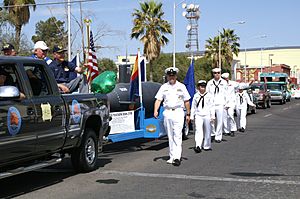
There are two Fourth Avenue Street Fairs each year. They happen in December and in late March/early April. They feature arts and crafts, food, and street performers. The fairs started in 1970.
Tucson Rodeo (Fiesta de los Vaqueros)
This popular rodeo happens in February. It includes "the world's largest non-mechanized parade." Many schools give two days off for the rodeo. People in Tucson often wear Western clothes during this time. The Fiesta de los Vaqueros starts the rodeo season in the U.S.
Tucson Meet Yourself
Every October, this festival celebrates Tucson's many ethnic groups. The downtown area features dancing, singing, art, and food. Performers are all from Tucson and the surrounding area.
All Souls Procession Weekend
The All Souls Procession is one of Tucson's biggest festivals. It happens in early November. It's like the Mexican holiday Dia de los Muertos. It started in 1990 with 35 people. Now, about 50,000 people take part. The procession is a non-motorized parade through downtown. It has floats, sculptures, and memorials. It ends with the burning of an urn filled with prayers.
Cyclovia Tucson
Cyclovia Tucson is an event where streets are closed to cars. People can walk, bike, and roll freely. It happens twice a year, in spring and fall. It turns the streets into a big block party.
Other Fun Places to Visit
- Mission Garden: An outdoor museum about farming in the Sonoran Desert.
- Arizona Historical Society: Learn about Arizona's past.
- Mission San Xavier del Bac: A beautiful historic mission.
- Old Tucson Studios: A movie set and theme park for Western movies.
- Tucson Museum of Art: Features art from different periods.
- Center for Creative Photography: A museum with photos by famous artists.
- DeGrazia Gallery in the Sun: An iconic art gallery built by Ted DeGrazia.
- Titan Missile Museum: A Cold War-era nuclear missile silo you can visit.
- Pima Air & Space Museum: Has many aircraft on display.
- Trail Dust Town: An outdoor shopping and restaurant area.
- Jewish History Museum: Learn about Jewish history in the area.
- Centennial Hall: The University of Arizona's auditorium.
- Arizona State Museum: On the University of Arizona campus.
- Museum of Contemporary Art, Tucson: Features modern art.
Fourth Avenue and University Boulevard are popular areas. They have many shops, restaurants, and bars. El Tiradito is a religious shrine downtown. It's based on an old love story. People light candles there for those in need. Biosphere 2 is a large facility that mimics different climates.
Music and Performing Arts
Tucson has a rich music scene. The Tucson Symphony Orchestra is the oldest performing arts group in Arizona. The Tucson Arizona Boys Chorus and the Tucson Girls Chorus perform locally and internationally.
Tucson is also known for its Mariachi music. The Tucson International Mariachi Conference happens every April. It brings together many mariachi bands. The city also has a strong punk music scene. Famous musicians from Tucson include Linda Ronstadt and Calexico.
Many films and TV shows have been filmed in Tucson. These include Revenge of the Nerds and Tombstone. Old Tucson is a popular spot for filming Westerns.
Tucson's Delicious Food
Tucson is famous for its Sonoran-style Mexican food. In 2015, UNESCO named Tucson a "world city of gastronomy." This means it's recognized for its amazing food culture. The Mission Garden shows crops grown here for over 4000 years.
The Sonoran hot dog is a must-try in Tucson. It's a hot dog wrapped in bacon. It's served on a special bun with beans, onions, tomatoes, and other toppings. Tucson also claims to be the birthplace of the chimichanga.
Tucson's Nicknames
Tucson is often called "The Old Pueblo." This nickname might have come from Mayor R. N. "Bob" Leatherwood. When the railroad arrived in 1880, he called Tucson an "ancient and honorable pueblo."
In the 1980s, the city tried to find a new nickname. The winner was "Sunshine Factory." But people still preferred "The Old Pueblo." Tucson was also called "Optics Valley" in 1992. This was because of its important optics industry.
Sports and Fun in Tucson
Tucson doesn't have teams in the major U.S. sports leagues. But the University of Arizona's sports teams are very popular. Their men's basketball team won a national championship in 1997. The softball team has won 8 national championships. The baseball team has won 4 national championships.
In ice hockey, the Tucson Roadrunners play at the Tucson Convention Center Arena. They are connected to the Utah Hockey Club. In American football, the Tucson Sugar Skulls play in the Indoor Football League.
For baseball, the Tucson Saguaros play at Kino Veterans Memorial Stadium. They have won three championships. Tucson also hosts the Mobile Mini Sun Cup for Major League Soccer (MLS) teams. Many MLS teams train in Tucson during the winter.
The United States Handball Association Hall of Fame is in Tucson. Tucson Raceway Park hosts auto racing. Rillito Downs is a historic track for quarter horse races.
Parks and Outdoor Activities
Tucson has over 120 parks. Some are small, and others have ballfields and lakes. There are also 5 public golf courses. The Reid Park Zoo is a popular spot.
The Loop is a great system of paved paths. It goes around the city, mostly along riverbeds. It's perfect for walking, running, and biking.
Other scenic places nearby include:
- Tucson Botanical Gardens
- Tohono Chul Park
- Saguaro National Park
- Sabino Canyon
- Biosphere 2 (just north of the city)
Tumamoc Hill is a popular walking and running trail. It's a research site for the University of Arizona. It offers great views of the city.
Mt. Lemmon is about 25 miles north of Tucson. It's over 6,700 feet higher than the city. You can hike, mountain bike, and rock climb there. In winter, you can even ski at the southernmost ski resort in the continental U.S.
Tucson is very bicycle-friendly. The League of American Bicyclists gave Tucson a gold rating. The city has many bike routes and trails. The Loop has 131 miles of paved, car-free trails. Many cycling teams train in Tucson because of its great year-round biking weather.
Education in Tucson
Colleges and Universities
- University of Arizona: A large university with over 36,000 students.
- Pima Community College: Has ten campuses.
- Arizona State University: Offers social work degrees in Tucson.
- Other colleges include Tucson College, Brookline College, University of Phoenix, and Northern Arizona University.
Schools for Kids
Most students in Tucson go to public schools in the Tucson Unified School District (TUSD). TUSD is the second-largest school district in Arizona. There are also many publicly funded charter schools. Other school districts include Sunnyside, Marana, and Amphitheater.
In 1956, Tucson High School had the most students of any high school in the U.S. It had over 6,800 students!
Media in Tucson
Newspapers and Magazines
Tucson has one daily newspaper, the Arizona Daily Star. Other publications include The Daily Territorial, Tucson Weekly, and Inside Tucson Business. TucsonSentinel.com is an online news organization. There are also monthly magazines like Tucson Lifestyle Magazine.
TV Stations
Tucson has many local TV stations. They include:
- KVOA 4 (NBC)
- KUAT-TV 6 (PBS)
- KGUN 9 (ABC)
- KMSB-TV 11 (Fox)
- KOLD-TV 13 (CBS)
- KHRR-TV 40 (Telemundo)
- KUVE-DT 46 (Univision)
How Tucson Works: Infrastructure
Energy
Tucson gets most of its electricity from a natural gas power plant. Solar power is also growing in Tucson. This is because Tucson gets over 300 days of sunshine each year. Many homes have solar systems.
Tucson and Pima County have "dark sky" rules. These rules control light pollution. This helps the many astronomical observatories in the region.
Water
The Santa Cruz River used to flow all year in Tucson. But this water supply has decreased. Tucson now gets water from the Central Arizona Project (CAP) and from underground water (groundwater).
Tucson is working to save water. It recharges groundwater by letting CAP water soak into the ground. The city also provides reclaimed water for irrigation and other uses. Tucson offers money to residents who collect rainwater. This helps save water and energy.
Getting Around Tucson
Public Transportation
Tucson's Sun Tran bus system serves the area. It has standard, express, and shuttle bus services. It was named "Best Transit System" in 1988 and 2005. A 3.9-mile streetcar line, Sun Link, connects the University of Arizona campus to downtown. The streetcar started service in 2014. Sun Tran buses have been free to ride since 2020.
Trains and Planes
Amtrak provides passenger train service to Tucson. The Sunset Limited and Texas Eagle trains stop here.
Tucson International Airport (TUS) is 6 miles south of the city. It's Arizona's second-largest commercial airport. It has nonstop flights to 15 U.S. cities. The airport also supports the 162nd Fighter Wing's F-16 jets.
Roads
Two Interstate highways are in Tucson. I-10 goes through the city. Interstate 19 goes south to the Mexican border. Tucson does not have a beltway system. It mainly uses surface streets.
Biking
Biking is very popular in Tucson. The city has many bike routes and trails. The Loop is a network of paved, car-free trails. It's 131 miles long and goes around most of the city. The League of American Bicyclists gave Tucson a gold rating for being bike-friendly.
Notable People from Tucson
Many famous people have lived in Tucson.
Sister Cities
Tucson has several sister cities around the world:
 Ciudad Obregón, Mexico
Ciudad Obregón, Mexico Guadalajara, Mexico
Guadalajara, Mexico Mazatlán, Mexico
Mazatlán, Mexico Pécs, Hungary
Pécs, Hungary Puerto Peñasco, Mexico
Puerto Peñasco, Mexico Roscommon, Ireland
Roscommon, Ireland Sulaymaniyah, Iraq
Sulaymaniyah, Iraq
Images for kids
See also
 In Spanish: Tucson para niños
In Spanish: Tucson para niños


